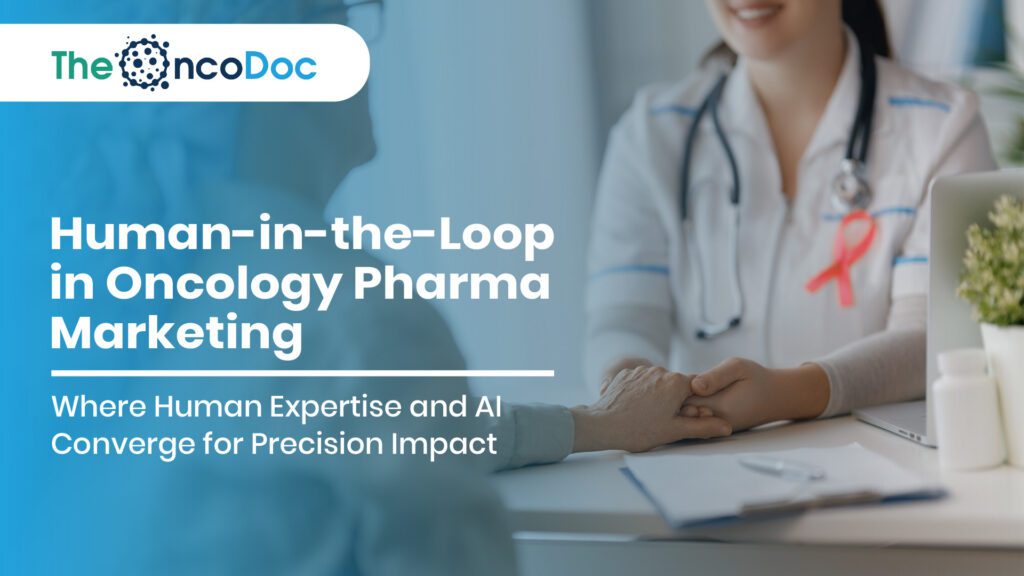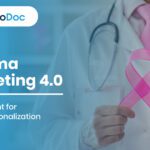Introduction: The Symbiosis of Human Expertise and Artificial Intelligence
The oncology landscape is evolving faster than ever, driven by innovations in diagnostics, precision therapies, and personalized medicine. For pharma marketers, this transformation demands a delicate balance between leveraging advanced artificial intelligence (AI) and retaining the human empathy, ethical oversight, and strategic vision that oncology marketing requires. Human-in-the-Loop (HITL) is emerging as a defining strategy, where AI and human expertise co-pilot every stage of marketing.
According to this model, AI handles the bulk of the work, processing intricate oncology datasets, forecasting patient and physician behavior, and creating campaign blueprints. Human marketers, on the other hand, make sure that compliance is maintained, add empathy, and improve strategies to effectively connect with patients, caregivers, and healthcare professionals (HCPs). The HITL framework doesn’t replace marketers; it empowers them to become leaders of data-driven storytelling, empathetic brand-building, and regulatory excellence.
This article explores how HITL is redefining oncology pharma marketing, from AI-powered insight generation to strategic decision-making, and why this synergy is essential in one of the most high-stakes industries in the world.
1. HITL as the Basis for Marketing in Precision Oncology
The complexity of oncology is too great for traditional marketing approaches to handle. Every patient’s cancer journey is different, every oncologist has a distinct prescribing style, and every region carries unique awareness gaps. AI can process terabytes of structured and unstructured data, clinical trial reports, real-world evidence, EHRs, prescription patterns, and even social sentiment, to identify trends and actionable insights.
But raw AI output lacks context. Here’s where HITL shines:
- Data Interpretation with Contextual Insight: AI may identify that oral cancer awareness is trending in rural states, but human experts interpret these findings in the context of cultural, economic, and literacy barriers.
- Ethical Oversight: AI predictions must be vetted by marketers, compliance teams, and medical reviewers to avoid bias, misinformation, or harmful messaging.
- Emotional Intelligence: In oncology, content tone is as important as accuracy. A human marketer ensures campaigns provide hope, not fear, while still being truthful.
This hybrid approach guarantees that oncology marketing strategies are not only data-driven but also emotionally and ethically resonant.
2. AI-Powered Data Analysis, Human-Driven Strategy
AI excels in extracting meaning from massive datasets, often uncovering micro-trends invisible to humans. From identifying oncologists most likely to adopt new therapies to mapping cancer incidence in underserved geographies, AI’s role is to enable precision targeting. However, these insights are only impactful when aligned with strategic human judgment.
For example:
- AI Role: Analyzes electronic health record (EHR) data to reveal a rise in HER2-positive breast cancer diagnoses in a metro region.
- Human Role: Decides whether to launch an educational series for oncologists, a patient awareness drive, or a combined initiative, factoring in local access barriers and community sensitivities.
This dynamic workflow ensures oncology campaigns are scientifically grounded but strategically nuanced.
3. Why HITL is a Necessity in Oncology Marketing
Unlike other therapeutic areas, oncology requires an extraordinary degree of empathy, trust, and precision. The following factors make HITL indispensable:
a) Empathy as a Differentiator
Oncology patients are often navigating fear, financial constraints, and complex treatment pathways. While AI-generated messages may be factually correct, humans can infuse empathy into narratives, ensuring messages feel supportive rather than clinical.
b) High-Stakes Compliance
Pharma marketing is one of the most heavily regulated sectors, and oncology even more so due to the life-changing nature of the drugs. HITL guarantees regulatory adherence, with humans acting as final gatekeepers.
c) Innovation with Responsibility
AI can suggest strategies based on probability, but only humans can decide if those strategies align with ethical frameworks and brand positioning.
This chart underscores the collaborative model where humans and AI share responsibilities, ensuring both scale and sensitivity.
4. HITL in Medical-Legal Review (MLR) and Regulatory Workflows
Content approval cycles in oncology marketing are notoriously slow. AI can act as a pre-screening tool, automatically flagging potential compliance risks and ensuring all citations are valid. This reduces manual effort and accelerates time-to-market for campaigns. However, the HITL system ensures that all final decisions are made by qualified medical and legal reviewers, safeguarding accuracy and accountability.
Example Workflow:
- AI flags missing disclaimers or noncompliant claims.
- Humans review, validate, and approve the content, ensuring adherence to regional guidelines.
- AI learns from human feedback, improving its pre-screening accuracy over time.
This combination optimizes efficiency while maintaining the rigorous standards expected in oncology communications.
5. Enhancing Omnichannel Campaigns through HITL
Patients and HCPs now expect seamless, personalized engagement across multiple channels: WhatsApp messages, webinars, social media, in-clinic kiosks, and more. HITL ensures AI-driven personalization doesn’t cross ethical lines or alienate sensitive audiences.
For instance:
- AI is able to dynamically modify the timing of campaigns according to engagement numbers.
- Humans fine-tune tone and imagery for vulnerable groups, such as pediatric cancer caregivers.
6. HITL for Predictive Oncology Marketing
Oncology marketing is increasingly relying on predictive analytics. AI can anticipate rising incidence trends or treatment adoption patterns. But AI’s predictive power is maximized when humans apply contextual judgment.
Example: If AI predicts a surge in colorectal cancer in urban centers, a marketer might integrate this insight with socioeconomic data, realizing that certain districts lack colonoscopy facilities. Campaigns are then designed not just for awareness but also for resource mobilization.
This data highlights HITL’s ability to boost accuracy, trust, and engagement, critical success metrics in oncology marketing.
7. HITL in Brand Storytelling and Creative Strategy
AI can suggest headlines, email subject lines, or audience segments, but only humans can craft a brand narrative that resonates emotionally. In oncology, brand stories are deeply tied to hope, survivorship, and innovation. HITL ensures:
- Cultural Relevance: Humans tailor AI-generated content to local languages and cultural nuances.
- Emotional Depth: Survivor stories gain authenticity when edited by humans who understand tone and empathy.
- Brand Differentiation: Marketers decide which narratives best highlight a company’s unique value proposition.
8. The Trust Imperative: Building HCP and Patient Confidence
Trust is the foundation of oncology marketing. Even the most advanced AI cannot replace human interactions between sales reps, medical science liaisons (MSLs), and oncologists. HITL reinforces this trust:
- AI identifies the right oncologist for engagement, but humans conduct sensitive, impactful conversations.
- AI analyzes patient feedback; humans turn those insights into actionable empathy-driven campaigns.
Trust remains a primarily human-driven outcome, with AI playing a supporting role through transparency and data reliability.
9. Case Example: AI-Human Collaboration in Oncology Awareness Campaigns
Consider a lung cancer awareness campaign:
- AI’s Role: Identifies target demographics based on smoking prevalence, predicts content engagement rates, and drafts campaign visuals.
- Human Marketer’s Role: Reviews messages to ensure they do not stigmatize smokers, integrates survivor stories, and builds partnerships with NGOs for screening camps.
The HITL model turns a data-rich initiative into an emotionally powerful movement, leading to higher screening participation rates and improved brand trust.
10. HITL for Emotional Analytics in Campaign Optimization
AI-powered emotional sentiment analysis evaluates comments, engagement, and reactions to marketing content. While AI detects negative sentiment spikes, humans interpret why. For example, a campaign may unintentionally evoke fear; human experts can recalibrate messaging for reassurance, demonstrating the ongoing importance of empathy.
11. HITL-Driven Personalization Without Overreach
AI hyper-personalization risks overstepping privacy boundaries, especially in oncology, where medical data sensitivity is paramount. HITL allows marketers to:
- Vet personalization strategies for ethical soundness.
- Ensure that content tailored for individuals does not violate HIPAA or GDPR regulations.
- Craft educational campaigns that feel helpful, not invasive.
12. Training AI with Human Feedback Loops
The “loop” in HITL is not static; it’s iterative. Each human intervention improves the AI model’s future performance. Oncology marketing teams act as trainers, feeding curated feedback to refine AI-driven recommendations over time.
Benefits include:
- Reduced compliance errors.
- Better cultural sensitivity in messaging.
- Improved prediction accuracy for campaign ROI.
13. HITL for Multilingual and Cultural Campaign Execution
Cancer awareness campaigns are far more effective when delivered in vernacular languages and aligned with cultural practices. AI can provide machine translations, but humans ensure idiomatic correctness and emotional resonance, especially in rural or underserved populations.
14. Real-Time Market Adaptation
In oncology, market conditions shift rapidly, new therapies launch, regulatory approvals roll out, or clinical trial data emerges. HITL enables marketers to respond quickly:
- AI tracks regulatory updates in real time.
- Humans decide how to pivot campaign narratives or reframe content ethically.
15. Preparing Marketers for an AI-HITL Future
HITL adoption requires pharma marketers to upskill. Future oncology marketing leaders will need:
- A solid understanding of AI algorithms.
- Expertise in regulatory processes.
- Training in emotional intelligence and ethical decision-making.
This blend of technical, strategic, and human-centered expertise will define the next generation of oncology pharma marketers.
16. HITL for Rare Cancer Awareness and Ultra-Targeted Marketing
Rare cancers, such as sarcomas or neuroendocrine tumors, often lack the awareness and research funding of more prevalent cancers. AI can sift through global databases, medical journals, and niche patient forums to identify emerging trends or unmet needs in these markets. However, humans are essential to bring a voice to these patients:
- Patient-First Narratives: Human marketers collaborate with survivors to create campaigns that shine a light on underdiagnosed cancers, helping early detection efforts.
- Ethical Advocacy: While AI highlights market gaps, humans advocate for equal access to information, ensuring that campaigns don’t overlook marginalized populations.
- Physician Education: HITL campaigns empower oncologists to detect rare cancers earlier, combining AI-led predictive models with human-driven CME (Continuing Medical Education) content.
Rare cancer marketing requires this balanced HITL approach to create empathy-driven campaigns that prioritize advocacy over profit while raising brand credibility.
17. HITL in Clinical Trial Recruitment Marketing
One of oncology’s biggest bottlenecks is patient recruitment for clinical trials, especially in regions with low awareness. AI models can analyze patient health records, genomics, and behavioral data to identify eligible candidates and predict enrollment likelihood. Yet, patients often hesitate to join trials due to fear or mistrust.
Here’s where humans step in:
- Personalized Conversations: Human outreach teams, trained in cultural and emotional intelligence, can explain trial benefits, risks, and logistics with compassion.
- Transparency and Trust: Medical Science Liaisons (MSLs) customize communications using AI-generated insights, but human agents make sure every exchange feels sincere and educational.
- Reducing Disparities: HITL allows pharma companies to actively recruit underserved patients, improving trial diversity, and making new therapies more accessible to all demographics.
This model accelerates trial timelines, democratizes access to innovation, and creates trust among patients who may otherwise feel excluded from cutting-edge treatments.
18. HITL in Crisis Communication and Reputation Management
In oncology, a single misinformation wave, such as claims about miracle “natural cures” or mistrust in immunotherapies, can undermine years of awareness efforts. AI-powered social listening detects these crises in real-time, identifying harmful narratives spreading across online communities. Humans, however, are responsible for crafting measured, empathetic responses.
- AI Alerts, Human Response: AI flags an alarming spike in anti-chemo sentiment; human marketers immediately deploy educational campaigns led by trusted oncologists.
- Rebuilding Trust: Humans craft long-term reputation strategies to address skepticism, focusing on empathy and education rather than aggressive marketing.
- Proactive Crisis Plans: With AI-driven simulations predicting possible backlash scenarios, HITL teams create contingency plans that ensure pharma brands remain trusted authorities in public health conversations.
In this dynamic, AI acts as an early-warning system, while human expertise protects brand integrity and patient confidence.
19. HITL and the Future of “Pharma as a Partner” Models
The future of oncology marketing is about transformation from being perceived as a seller of drugs to becoming a holistic partner in health ecosystems. HITL is at the core of this shift:
- Collaborative Ecosystems: AI suggests strategic partnerships (with NGOs, insurers, tech companies), but humans negotiate these alliances to create long-term value.
- Patient Empowerment Platforms: HITL teams co-create digital platforms where patients can access educational resources, track treatment progress, and connect with experts.
- From Marketing to Mentorship: Human-led outreach programs, supported by AI insights, focus on equipping patients and caregivers with tools to navigate cancer journeys, turning pharma brands into trusted mentors.
This evolution allows brands to transcend traditional marketing roles and establish themselves as lifelong partners in patient care.
Conclusion: HITL as a Catalyst for a Human-First, AI-Powered Future
Human-in-the-Loop (HITL) is not simply a technological workflow; it’s a cultural shift. In oncology pharma marketing, where emotions run deep and stakes are life-changing, HITL ensures that innovation never outpaces empathy.
- AI acts as the architect of scale, offering data-driven predictions, hyper-personalized campaigns, and real-time monitoring.
- Humans serve as the guardians of ethics and trust, ensuring messages remain sensitive, compliant, and culturally relevant.
This powerful synergy is positioning oncology marketers as strategic leaders rather than tactical executors. By freeing professionals from repetitive tasks, HITL empowers them to focus on creativity, patient advocacy, and relationship-building.
Future campaigns will no longer be measured solely by engagement metrics, but by how effectively they bridge information gaps, accelerate early diagnosis, and build authentic trust between patients, oncologists, and pharma brands.
In this HITL-driven future, marketing transforms into a public health force, where every campaign has the potential to save lives. The oncology marketer becomes not just a storyteller but a data-empowered advocate for patients, ensuring no innovation is lost in translation and no patient feels left behind.
The Oncodoc team is a group of passionate healthcare and marketing professionals dedicated to delivering accurate, engaging, and impactful content. With expertise across medical research, digital strategy, and clinical communication, the team focuses on empowering healthcare professionals and patients alike. Through evidence-based insights and innovative storytelling, Hidoc aims to bridge the gap between medicine and digital engagement, promoting wellness and informed decision-making.



